28
Vesiculopustular and Erosive Disorders in Newborns and Infants
This chapter covers classic transient neonatal eruptions as well as several infectious diseases and other disorders that present with vesiculopustules in the neonatal period or early infancy. Table 28.1 provides a more complete differential diagnosis of vesiculopustules, bullae, erosions, and ulcerations in neonates.
Common Transient Conditions
Erythema Toxicum Neonatorum (‘e tox’)
• Affects approximately half of full-term neonates; less common in premature infants.
• Various combinations of erythematous macules, wheals, and small (≤2 mm) papules, pustules, and vesicles surrounded by a larger erythematous flare (Fig. 28.1); lesions may be grouped at sites of mechanical irritation.
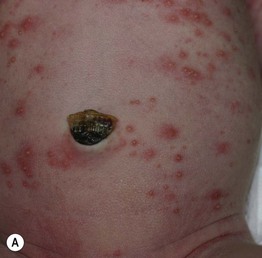
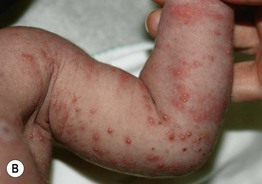
Fig. 28.1 Erythema toxicum neonatorum. Scattered papulovesicles and pustules with an erythematous flare on the abdomen (A) and upper extremity (B). Courtesy, Deborah S. Goddard, MD, Amy E. Gilliam, MD, and Ilona J. Frieden, MD.
• Wright’s stain of pustular contents shows numerous eosinophils.
Transient Neonatal Pustular Melanosis
• Lesions are almost always present at birth.
• Three stages, any of which may be present at a given time (Fig. 28.2).
– 2- to 10-mm superficial vesiculopustules with little or no surrounding erythema.
– Collarettes of scale at sites of ruptured vesiculopustules.
– Residual brown macules representing post-inflammatory hyperpigmentation, which may persist for several months.
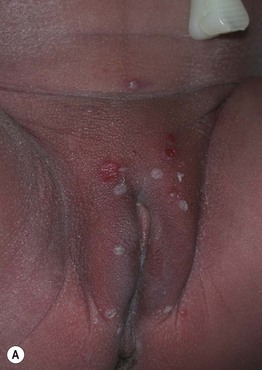
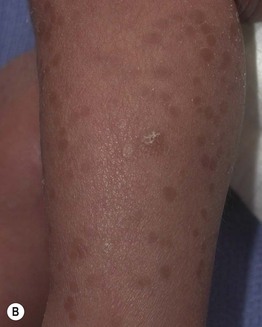
Fig. 28.2 Transient neonatal pustular melanosis in an African-American neonate. A One hour after birth, flaccid vesiculopustules and superficial erosions with minimal surrounding erythema are present in the groin. B On the 8th day of life, hyperpigmented macules and a few collarettes of scale are evident on the lower leg.
• Any region can be affected, but favors the forehead, chin, neck, lower back, and shins.
• Wright’s stain of pustular contents shows neutrophils > eosinophils.
Miliaria (Heat Rash)
• Caused by blockage of eccrine sweat ducts.
– Small clear vesicles (likened to ‘dew drops’) without surrounding erythema (Fig. 28.3); they are fragile and therefore short-lived.
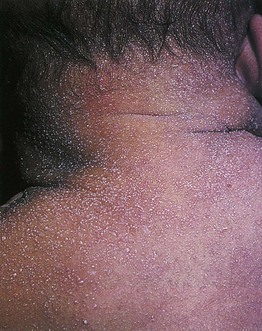
Fig. 28.3 Miliaria crystallina. Tiny, superficial vesicles, seen on the back and neck of this newborn, are characteristic of miliaria crystallina. From Eichenfield L.F., Frieden I.J., Esterly N.B., et al. (Eds.). Textbook of Neonatal Dermatology. © 2001 Saunders.
– Small erythematous papules, sometimes with a tiny central pustule or vesicle.
• Rx: avoid overheating and occlusion; bathing with lukewarm water.
Neonatal Cephalic Pustulosis (Neonatal Acne)
• Onset usually at 2–3 weeks of life, with spontaneous resolution by 2–3 months of age.
• Papulopustular eruption on the face (cheeks > forehead, chin, eyelids) (Fig. 28.4) > neck, upper chest, and scalp.
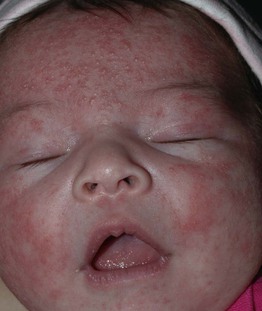
Fig. 28.4 Neonatal cephalic pustulosis. Papulopustules on the forehead and cheeks of a 3-week-old infant. Courtesy, Julie V. Schaffer, MD.
• An absence of comedones in neonatal cephalic pustulosis distinguishes it from infantile acne, which typically develops at 3–12 months of age and is more persistent (see Chapter 29).
• Rx: usually not required; topical imidazoles (e.g. ketoconazole cream) may be helpful.
Stay updated, free articles. Join our Telegram channel

Full access? Get Clinical Tree








